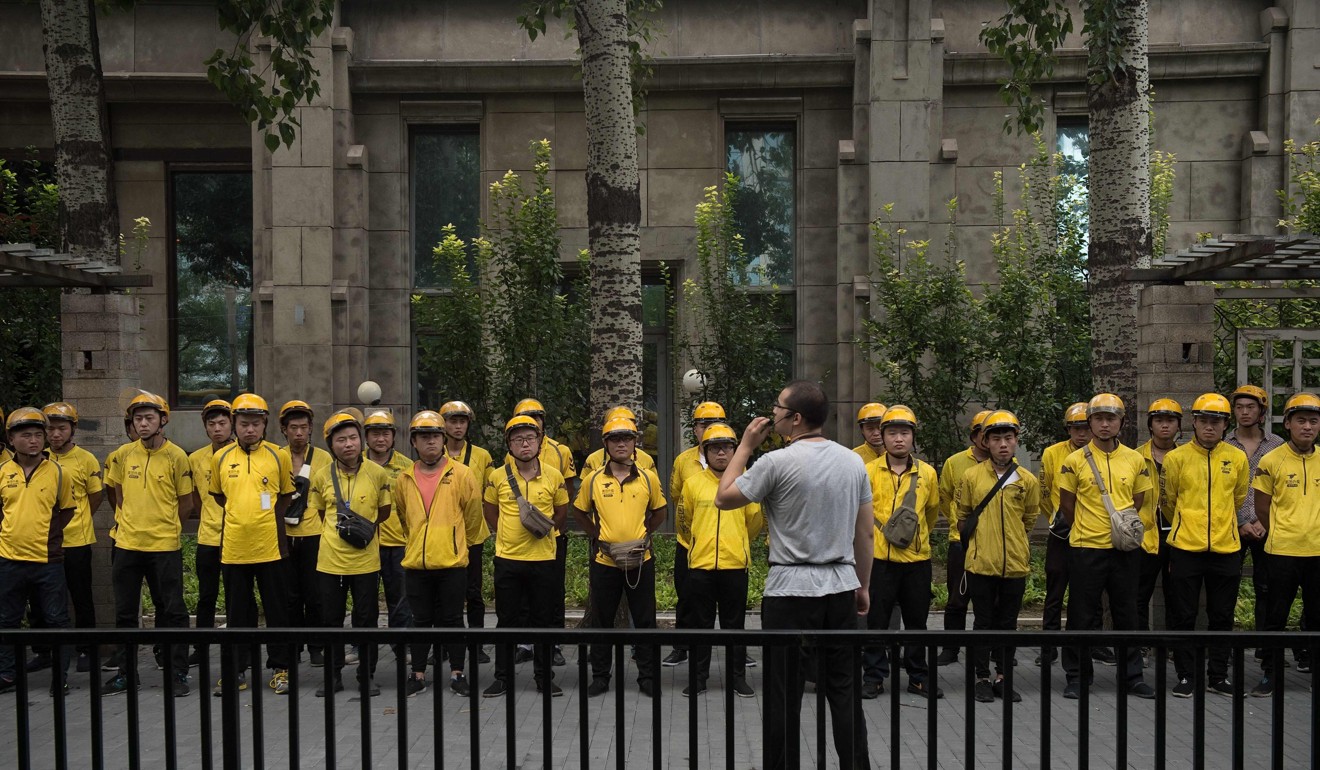
China’s makers stave off trade war job losses – but for how long?
- Service sector has absorbed many workers laid off during the slowdown and trade conflict, but manufacturing jobs may drop more sharply in 2019
- Labour situation much worse at smaller firms than larger companies
China’s private sector, the driving force behind the country’s economic miracle over the last 40 years, is struggling amid the Chinese government’s campaign to reduce national debt and the trade war with the United States. This is the fourth story in a series that will detail the challenges private firms face and outline the government’s attempts to address them.
It’s a frustrating time for Chinese furniture makers like Jason Chen, whose meagre profits have fallen victim to the US-China trade war. But the dark cloud of that conflict has one silver lining: good technical workers are no longer so hard to find.
Chen, who manages two factories that make wooden frames for sofas and tables in eastern China’s Jiangsu and Zhejiang provinces, has not had to lay off any of his 600 staff despite the blow to his business. He was fortunate to have a mostly independent supply chain, but still had to scale down the workforce in the smaller factory and move them to the bigger factory to save costs.
In late October, he hired two experienced sample makers laid off by other factories. Their salary demands were “not too high”, because there were few other jobs to be had.
However, not everyone is fortunate and capable enough to spread risk among different baskets.
“If between half and 70 per cent of one’s business comes from the US market, then it’s hard to survive,” Chen said. “I estimate that small manufacturers with fewer than 200 employees will disappear after January.”
That is when US tariffs on US$200 billion worth of Chinese imports, including furniture, were initially scheduled to rise to 25 per cent from the initial 10 per cent rate levied in September. But after US President Donald Trump and Chinese President Xi Jinping met on December 1, the tariff increase was put on hold until March while the two nations continue trade negotiations.
The trade war has created an extra, unexpected burden for Beijing: to maintain enough jobs as the economy slows. This is particularly true, given the extra hardship they face, for private-sector firms, which account for about 80 per cent of all jobs and 90 per cent of new jobs, according to government data.
Last year, China was the largest exporter of furniture to the United States, with US$11.3 billion worth. The tariffs have had a chilling effect on its 6,000-plus domestic furniture manufacturers, most of which are privately owned, and reduced the number of employees in the industry to about 1.1 million at the end of October, the lowest in three years, according to official data.
The top leadership knows well the importance of having enough jobs. In the statement that followed the latest meeting of the policymaking Politburo in December, stabilising employment was mentioned first, before efforts to stabilise finance, trade and market expectations.
On the surface, the job market seems well under control. The official survey-based unemployment rate released by the National Bureau of Statistics remained unchanged at 4.9 per cent in September and October before falling slightly to 4.8 per cent in November, while the average jobless rate in 31 major cites was even lower at 4.7 per cent in November – compared with the global average rate of 5.7 per cent reported by the International Labour Organisation.
According to the Chinese Ministry of Human Resources and Social Security, the government created more than 12 million new jobs in urban areas during the first 10 months of this year, achieving its annual target two months early.
But the overall numbers hid a stark difference in the available supply of labour between small and large firms. For private enterprises with a workforce of fewer than 100 employees, job supply fell below demand in the third quarter, whereas large firms offered an average of 2.87 jobs for every applicant, according to the China Institute for Employment Research (CIER) at the Renmin University of China in Beijing.

Using job data from April to September from recruitment website 51jobs, Song Xuetao, an economist from Tianfeng Securities, found that about 2 million vacancies disappeared over the six months, and that recruitment by private firms with 50 to 500 staff fell more sharply than for state-owned enterprises.
“Under the current economy, small and micro firms contribute 80 per cent of all jobs, around 70 per cent of technological innovation, more than 60 per cent of GDP and more than 50 per cent of tax revenues,” said Dong Dezhi, an analyst from Guoxin Securities.
“Turning around the businesses of small and medium enterprises to help job creation is where we can make a breakthrough to stabilise the job market.”
Beijing has certainly become a little restless as the trade war continues. In mid-November, the State Council drafted a policy paper containing proposals ranging from refunding the unemployment insurance contributions of companies that do not lay off staff to giving subsidies to jobless youth, ages 16 to 24. Local governments were ordered to draft their own proposals by mid-December.
Beijing also called for local governments to increase their financial support for entrepreneurs and small private enterprises – the main driver of urban employment in China – by offering government-guaranteed loans of 150,000 to 3 million yuan (US$22,000 to US$435,000).
The government is also encouraging laid-off workers to set up small businesses of their own. Migrant workers in particular are being given subsidies, tax breaks and other financial incentives to “return home and start up” their own companies.
Since the early 2000s, almost all new jobs in China have been created in cities. The labour market is facing challenges from two ends: industrial consolidation and automation reduce the job supply, while a shrinking workforce, rising labour costs and declining job market participation – driven down mainly by women leaving the labour force – all contribute to depressing job demand.
But thanks to a surge in service jobs, particularly at small companies, urban employment growth has remained relatively stable even as China’s economy has slowed.
“Both basic and advanced services are contributing to this [jobs] growth, but it’s the basic services industries that have been the stronger growth driver in most recent years,” read a recent report from the Conference Board, a New York-based research firm.
“They have become the catch basin for the lower-skilled segment of the workforce, absorbing a large share of less-skilled workers, presumably transitioning from legacy sectors. Without the continued job growth from micro-enterprises, urban employment would in fact be contracting.”
The question is: can Beijing help small service providers keep creating jobs? Some recent figures are of concern. The employment sub-index in the November Caixin Purchasing Managers’ Index for the service sector, which mainly captures small private firms, showed that the workforce in the service industry grew mildly in the past two months but could not offset downsizing in the manufacturing sector.
A monthly survey from Hong Kong billionaire Li Ka-shing’s Cheung Kong Graduate School of Business gauging more than 300 alumni, mostly executives at private companies, also showed their intentions to recruit staff had plunged over the past two months to the worst level in six years.
In the export sector, hiring demand fell by more than half in the third quarter, according to the CIER, which partners with job hunting site Zhaopin to produce a quarterly report.

The supply of new jobs declined even more in coastal cities such as Ningbo and Suzhou that rely heavily on international trade.
Meanwhile, job postings in the internet and IT sector, which had been fertile ground for well-paid service jobs, fell by more than half in the third quarter from a year earlier. A senior executive at a mid-sized internet firm of about 1,000 employees, who preferred not to be identified, said she had raised performance targets to improve productivity, even though she had not frozen headcounts or laid off staff. She noted that many of the jobseekers knocking on her door came from the peer-to-peer lending industry, in which hundreds of platforms have collapsed since July after the government tightened regulations.
Earlier in October, reports of big tech firms like Huawei, Tencent and Alibaba freezing recruitment shocked the public. All those companies later denied the reports, but some smaller tech firms are scaling back operations.
Juanpi.com, an e-commerce platform selling cheap retail goods, has been demanding that employees work overtime since last year. Short video platform Kuaishou recently stopped hiring through headhunters, according to a recruiter source. Meituan Dianping, a Hong Kong-listed online platform that generates most of its revenue from food delivery, this year reported about 250 job cuts – 0.5 per cent of its workforce.
“Salary is a priority, but many candidates for tech start-ups care a lot about job stability at the moment,” said Eva Li, a Beijing-based headhunter who helps tech companies find engineers.
For now, the transition from industrial (secondary) jobs to service sector (tertiary) jobs seems smooth, partly because a strong economy over the past few years has created many entry-level, low-skilled jobs – such as in package or food delivery – but boosting entrepreneurship to offset demographic challenges requires consistent government support, which is easier said than done, according to Gao Yuan, senior economist at the Conference Board.
“As growth continues to slow, it will become increasingly difficult for the government to maintain the balancing act between upholding employment stability and advancing structural reforms,” Gao said.
One risky factor for employment stability is the rise in Chinese worker protests in service industries, according to China Labour Bulletin (CLB), a Hong Kong-based non-governmental organisation that tracks labour strikes. Of 1,444 incidents recorded during the first 10 months of this year, 238 were in retail and 224 in transport, which are dominated by online services such as ride-sharing giant Didi and Meituan Dianping.
“As these new businesses absorb more and more of the workforce laid off from the manufacturing sector, we would expect to see a greater number of strikes and protests over low pay, lack of benefits, long working hours and lack of job security. ”

